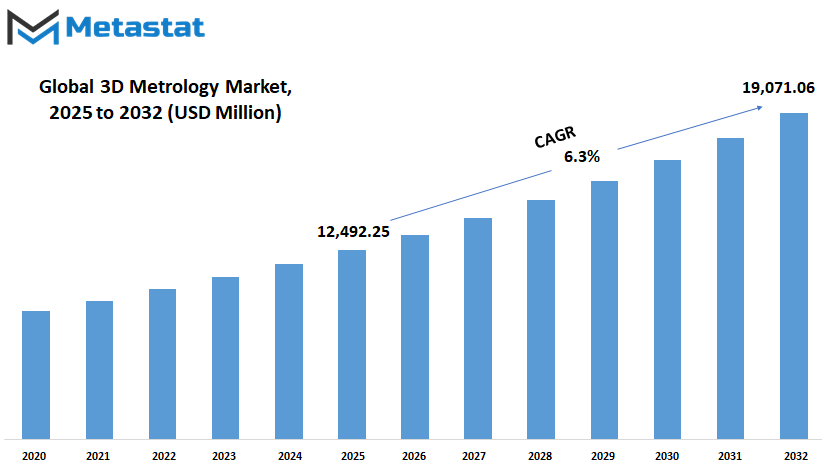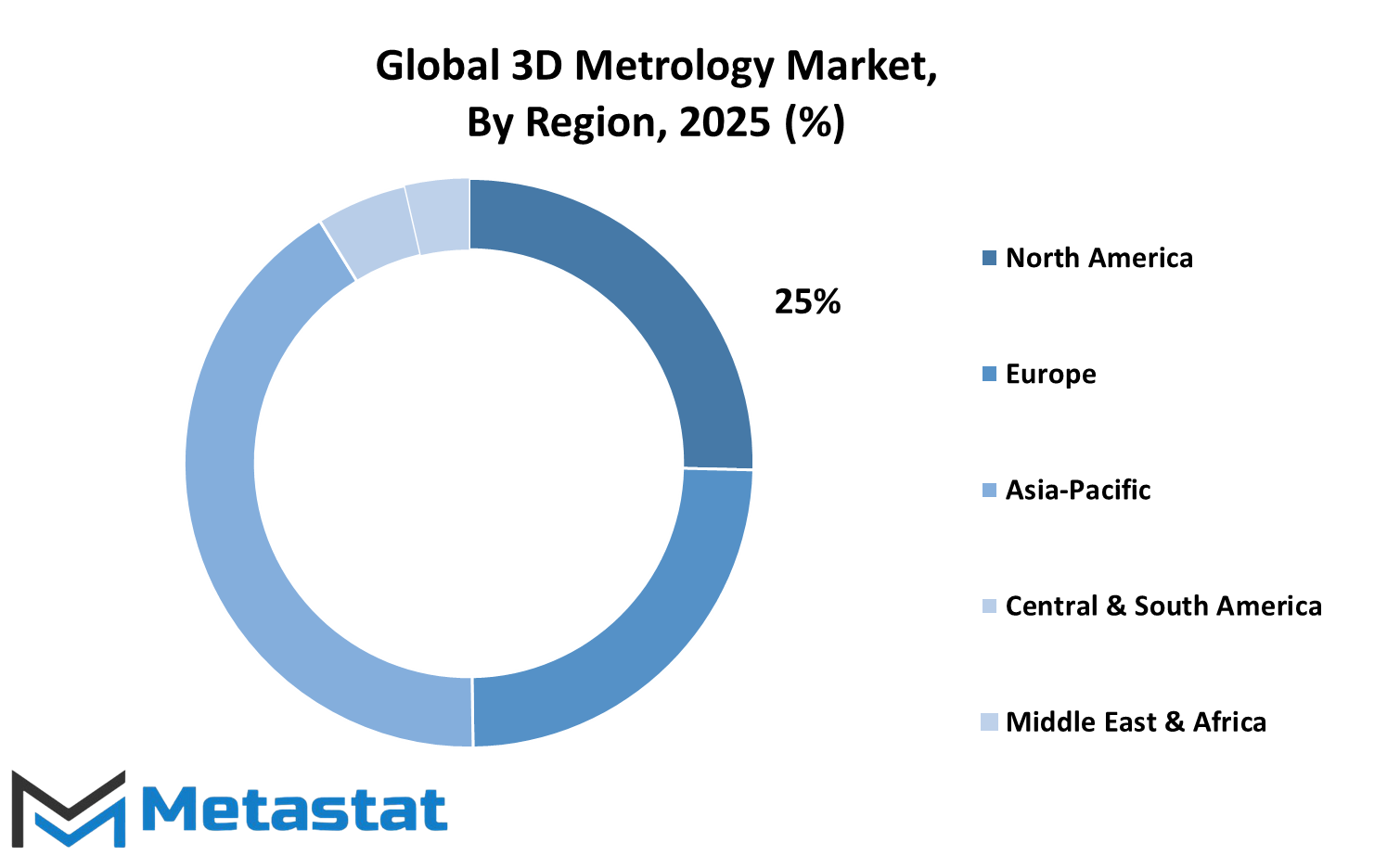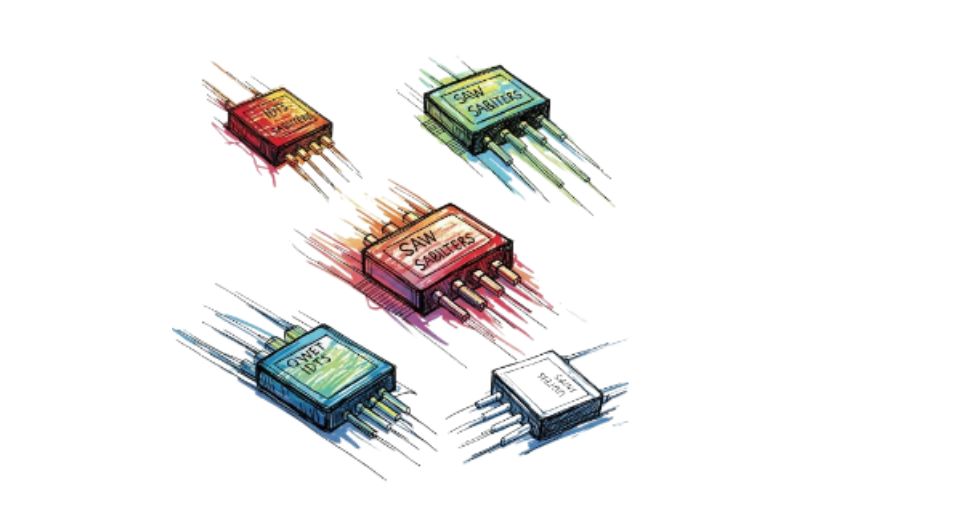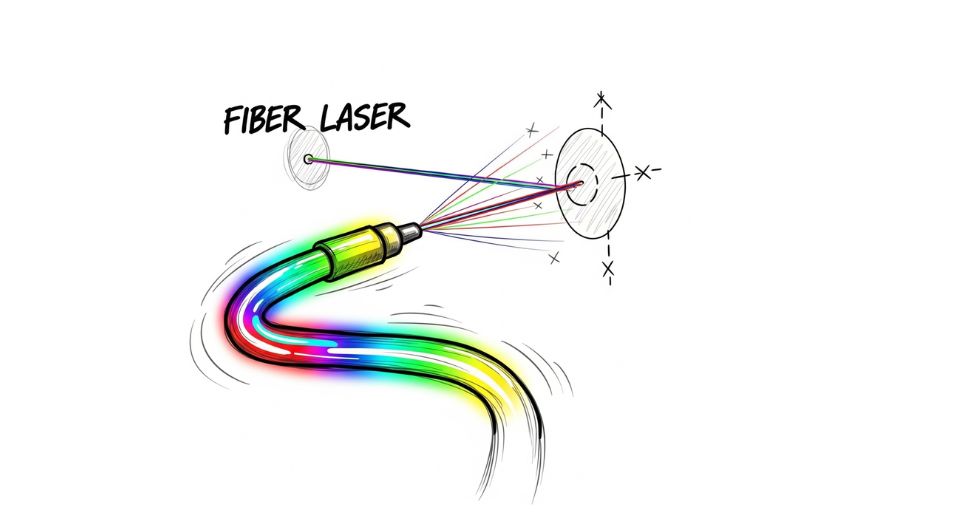MARKET OVERVIEW
The global 3D metrology market is the best example of precision measurement and quality assurance within all industries. What makes this market advanced, involved in the processes of the technologically driven manufacturing and inspection, is that it improves and achieves greater accuracy along with efficiency while dimensionally analyzing. Such demands thus exist in various industries, including aerospace, automotive, and healthcare. Apart from its conventional applications, the industry can transform the way businesses attain accuracy, develop potential production method ways, and consequently provide consistency with their productions.
3D Metrology extends usefulness beyond simple measures, transforming as a critical enabling tool for achieving manufacturing excellence. With its importance in optimizing lines of production and promoting real-time control of quality in production, market will continue the gap between designing and producing in subsequent years. Advanced manufacturing systems will witness companies increasingly seek to obtain these solutions that will help the companies achieve extreme levels of personalization and lower error rates for their processes.
Apart from that, as industries evolve to become smarter to operate, 3D metrology systems will be accompanied by automation platforms that will re-engineer all the workflows of operation in the industry.The most sought-after aspect of this market is the way it can catch up with the need for intricate geometries and engineering stringency in contemporary designing.
The call for more rigid tolerances and high accuracy in numerous sectors will push these systems to their limits beyond what they currently can do. For instance, as aircraft parts become increasingly sophisticated, 3D metrology systems will evolve to offer the level of precision that is required to manufacture lightweight yet resilient components. This automotive industry, constantly seeking better fuel economy and safety characteristics, will rely on such solutions to perform a holistic check-up of the said parts. The healthcare industry will also see tremendous growth with the global 3D metrology market. Personalized medicine and custom prosthetics make the need for accurate anatomical measurements more frequent, thereby fueling the adoption of 3D scanning and modeling technologies. These systems will enable the production of patient-specific devices and enhance the results of medical procedures. The capability to map the human body with unprecedented accuracy will be a revolutionizing element in healthcare provision.
In the near future, this market will be seen more with the impact of technologies like artificial intelligence and machine learning. The combination of these technologies will allow 3D metrology systems to analyze data in a better manner and predict manufacturing defects before they happen. Synergies among these technologies and 3D metrology will revolutionize predictive maintenance, reduce downtime, and improve overall equipment efficiency in several industries.
In addition, market potential will not be confined to the industrial sector. Preservation of cultural heritage will increasingly depend on 3D metrology technologies to document artifacts and monuments so that they can be digitized, thus preserving them for generations to come. The potential to produce extremely detailed digital replicas provides new avenues for research and education.
In short, the future of precision engineering and innovation will arrive with the global 3D metrology market. It will usher in a new era of efficiency and accuracy while inducing mega-level changes in manufacturing and healthcare and more. And then, by continuously developing industry and advanced technology, it will be at the forefront to offer solutions to overcome tomorrow's challenge.
Global 3D metrology market is estimated to reach $19,071.06 Million by 2032; growing at a CAGR of 6.3% from 2025 to 2032.

GROWTH FACTORS
The global 3D metrology market is characterized by significant development spurred by numerous factors. Demand for high-precision industrial applications remains one of the primary reasons behind this increase in demand. Precision measurements for quality and reliability play a pivotal role in many aerospace, automotive, and manufacturing sectors. Precise tools and products are considered absolute necessities by such industries because the detail required from these measurements must be exceptional and stringent.
Another is a growing number of automation and quality control deployments in manufacturing. Automated solutions are increasingly becoming the integration of manufacturers towards efficiency, a decrease in the error rate, and the ability to keep a higher quality product throughout the process. Competitiveness of businesses in specific industries can therefore be ensured by streamlined production with such 3D metrology system integrations. This change fits into the growing trend toward the smarter practices that characterize the best manufacturing today in which the importance of data to inform decision is paramount. However, the market is not very easy to penetrate. Among the limitations of advanced 3D metrology systems, the high investment and maintenance cost stands out at number one.
Such sophisticated 3D metrology systems are immensely costly, an investment that sends shivers down the spines of small companies or even less supported ones. Additionally, the sophistication in the operation of such a sophisticated system is also a limiting factor for extensive utilization. Firms are required to incur substantial overhead costs and labor in terms of specialized training for the staff prior to its implementation. Despite this, there are significant opportunities in the market. One key space is the expansion of 3D metrology applications in developing markets. As these countries continue to industrialize, demand for accurate measurement equipment is likely to increase, opening up new prospects for businesses to access previously untapped markets.
Beyond this, advancements in AI-based metrology solutions are opening up more productive and intuitive systems. These innovations are simplifying the operation of complex tools, reducing human error, and enhancing the overall accuracy of measurements. As high expenses and operation complexities are the big concerns globally in reaching the objectives of 3D metrology, sustained growth can be effectively guaranteed by increasing demand for precision and automation and ongoing technological innovations and rising applications in mature markets. Businesses that embrace these developments and are able to manage the problems well will likely position themselves in a good place regarding long-term existence in this fast-changing market.
MARKET SEGMENTATION
By Product Type
The global 3D metrology market is adopting advanced measurement technologies by industries as a whole to grow rapidly. To break down and analyze the entire market, various product types under 3D Metrology exist, including Coordinate Measuring Machine (CMM), Optical Digitizer and Scanner (ODS), Form Measurement Equipment, Video Measuring Machine (VMM), 3D Automated Optical Inspection System (AOI), and other relevant devices. This reflects extensive uses across the automotive, aerospace, and manufacturing sectors, where specific measurements are well beyond required. Optical Digitizers and Scanners form another very important segment that is increasingly being used with the capability to measure accurately without ever touching the subject.
They find applications in industries requiring detailed surface analysis over products, such as electronics and consumer goods. Form Measurement Equipment is also on the list as it brings diversity to the market and is used when the form and surface quality of the components are a crucial factor in that. On the other hand, VMM Video Measuring Machines is an essential device used for quality control and for detecting defects or irregularities in manufactured products with high-resolution images. Some of the innovations that may enable automatic inspection with little human error and high productivity are the AOI 3D Automated Optical Inspection System.
AOI is increasingly becoming a common requirement in those industries with extremely high-speed, high-volume inspection, such as the semiconductor and electronics manufacturing. Another group that constitutes 3D metrology is special equipment that caters to niche applications under Others. The upsurge in dependence on the technology is necessitated by the urge for precision, productivity, and better quality of products for dominance in competitive markets. Numerous firms, irrespective of their industries, are leveraging 3D metrology tools to ensure that their products are of premium grade and compliant with rigorous standards. In addition, sophisticated software coupled with hardware has facilitated streamlined processes for better data analysis and decision-making.
All these technologies have a definite aim in their respective applications. In this sense, there is a commonality among all the technologies because their shared objective is to measure accurately and ensure quality. Increasing demand for high-performance equipment ensures growth for the 3D metrology industry. Evolving metrology solutions would most likely fuel innovation and development in the field as industries continue to grow.
By Application
Given the developing dependence of most industries on high-tech for precision and efficiency, the global 3D metrology market continues growing. This industry is thus important in many areas in order to be able to provide demand for accurate measurement and analysis in improving product quality, streamlined processes, and enhanced productivity. This goes into a number of areas, including Quality Control and Inspection, Reverse Engineering, Virtual Simulation, and some special functions. Quality Control and Inspection makes 3D metrology to play a part in making certain products are to standards and specifics.
It applies in finding a defect and getting the products regular so that its production wastes become reduced. All this happens primarily in industries as automotive, aerospace and manufacturing industries to make things really precise.
Product reliability is raised for it provides precision measurement on products to a great extent and hence gaining confidence among the customers too. Reverse Engineering is yet another extremely critical usage within the 3D metrology industry. The process of scanning the dimensions and characteristics of already present objects replicates or modifies them. Companies apply the technology most when they are redesigning their products or do not have design files. In this manner, companies can get digital models which form the basis of innovation so as to be competitive in fluctuant markets through 3D scanning technologies. Virtual Simulation is one of the applications that are very valuable in that it will enable industries to visualize and test their products before physical production.
This not only conserves time and money but also reduces the risks associated with the conventional trial-and-error process. Virtual simulation allows engineers and designers to make informed decisions right at the start of the development process, which enhances efficiency and saves costs. Apart from these primary uses, the 3D metrology market meets other niche requirements in different industries. These range from line assembly automation to medical imaging and tool calibration, which only go to prove how versatile this technology is. The diversity of 3D metrology instruments ensures that there is always something that can solve a unique challenge for a specific field.
The global 3D metrology market has solutions that are precise and reliable for various applications. Its role in product quality improvement, streamlining of operations, and innovation continues to expand to emerge as a critical resource for industries competing to meet demands in the modern world. As this technology advances further, the scope and effectiveness of 3D metrology will grow and, therefore, contribute meaningfully to industrial progress and development.
By Offering
The global 3D metrology market is growing gradually because industries seek measurement solutions with high precision. Such growth is brought about by the ever-increasing need for precise and efficient measurements across different sectors such as automotive, aerospace, electronics, and manufacturing.
The market is divided according to the type of offering. These offerings can be broadly classified into hardware, software, and services. All these segments hold great importance in the landscape of the market and cater to the needs of various end users. Hardware constitutes the central theme of the 3D metrology market. The equipment includes top-of-the-line measuring instruments like 3D scanners, coordinate measuring machines, and optical measurement systems. Such tools are designed to provide maximum accuracy and are employed for the verification of parts and products against quality standards. The development of smaller, more portable, and less expensive devices has contributed to the growth of 3D metrology tools in various industries.
This is due to the fact that, in seeking cost-efficient methods, business firms continue to seek better hardware that assures both precision and productivity. While the above is a crucial element of the market, the case is also of great importance on the software side. It examines and interprets the information from the hardware in order to create meaningful information that can easily assist manufacturers to identify defects, monitor quality, and improve overall productivity. Many software solutions for 3D metrology are cloud connected, allow for real-time sharing of data, and integrate other systems to facilitate a more streamlined workflow. As the demand for real-time data analysis and optimization increases, software solutions are becoming indispensable in ensuring that the metrology systems are efficient and effective. The services segment is also an important driver of market growth.
Such services would usually encompass calibration, installation, training, and maintenance of 3D metrology equipment. As the businesses invest in these technologies, there will be a growing demand for professional services to ensure that the equipment works optimally over time. The services aspect of the market will not only help businesses integrate these systems but also ensure their long-term efficiency and reliability. Summarily, the global 3D metrology market is dominated by three major segments of hardware, software, and services. All these offers need to exist for general growth and functionality of the market since they offer all tools, analysis, and support that industries worldwide may require in reaching of high standards of quality and precision. And the market will consistently see new developments in these segments as the technological progress continues, responding to the demand for accurate measurement solutions.
By End-User
The 3D metrology market is increasing around the world with significant growth across the sectors of the industries because of their high demands for high-precision measurement. This technology ensures accuracy of parts and components while being manufactured. Market can be categorized by end-users that are Aerospace & Defence, Automotive, Architecture & Construction, Medical, Semiconductors & Electronics, Energy & Power, Heavy Machinery, and others. In the Aerospace & Defence sector, 3D metrology is used for ensuring the accuracy and safety of parts that are put into aircraft and military equipment.
These sectors require high quality control standards, and metrology helps in meeting these standards through the inspection of complex parts. Aerospace components are tested under rigid conditions to satisfy the stringent requirements of safety regulation, and 3D metrology provides an effective solution to this process. Another significant end-user of 3D metrology is the Automotive industry. Car manufacturers use 3D scanning and measurement technologies for the design, production, and assembly of parts. This technology helps reduce errors during production, thus improving the overall quality of vehicles. Early detection and correction of issues during the production process save costs and produce better products. In the areas of engine components, body panels, and suspension systems, measurements are critical for precision. In Architecture & Construction, 3D metrology helps architects and engineers verify the accuracy of designs and ensure that buildings are constructed as planned. It measures structures and materials to assess the quality and alignment of building components.
This is important to ensure that structures are safe, durable, and meet building codes. In the medical sector, 3D metrology is used in the creation of prosthetics, medical equipment, and surgical instruments. This ensures that the product is highly precise to be applied to a patient. Since patients' health can be adversely affected by defective products, high-quality standards are demanded in this industry.
Semiconductors & Electronics have a strong requirement for 3D metrology in quality inspection and testing. The microchip components require the most precise measurement, and in testing and ascertaining whether these parts will work, 3D metrology is strongly involved.
In the Energy & Power sector, 3D metrology is employed to inspect equipment parts in power plants, wind turbines, and energy grids. This helps keep the equipment running efficiently with nominal downtime.
Finally, the industry of Heavy Machinery employs 3D metrology to inspect heavy machinery so that each component complements another and functions properly. This minimizes wear and tear, enhances machine life, and improves overall productivity.
In conclusion, the global 3D metrology market serves a wide array of industries, offering solutions that improve accuracy, efficiency, and safety in manufacturing and production processes. Each sector, whether it’s Aerospace, Automotive, or Heavy Machinery, benefits from the precision and reliability of 3D measurement technologies.
|
Report Coverage |
Details |
|
Forecast Period |
2025-2032 |
|
Market Size in 2025 |
$12,492.25 million |
|
Market Size by 2032 |
$19,071.06 Million |
|
Growth Rate from 2025 to 2032 |
6.3% |
|
Base Year |
2024 |
|
Regions Covered |
North America, Europe, Asia-Pacific Green, South America, Middle East & Africa |
REGIONAL ANALYSIS
The 3D metrology market is segmented on a worldwide basis by regions. The prominent regions are North America, Europe, Asia-Pacific, South America, and the Middle East & Africa. Sub-segmentation of North America comprises the United States, Canada, and Mexico. In Europe, the country is sub-divided into nations such as the United Kingdom, Germany, France, Italy, and other European countries. The market in Asia-Pacific is segmented into major countries like India, China, Japan, South Korea, and other Asia-Pacific countries. The major countries in the market in South America are Brazil, Argentina, and other countries in South America. On the other hand, the Middle East & Africa market is segmented into regions such as the GCC countries, Egypt, South Africa, and the rest of the Middle East & Africa.
They are able to make people realize the extent and expanse that the market offers in every regional zone. And each region contributes its own characteristics and necessitates the very particular requirements within 3D Metrology measurements and examination with the three dimensions of physical objects for ensuring accurate quality control. Identify all the regions and their segments. Thus, would be in a position to meet local needs while taking advantage of growth prospects for each region with the global 3D metrology market.
For instance, North America is a pioneer in innovations in 3D Metrology. Its inclination towards high-end technological adoption has numerous underlines this aspect. The demand is linked closely with Europe's manufacturing base. The region Asia-Pacific is highly important in this market, where industrial growth has been on the rise, mainly in countries such as China and India. The region of South America and Middle East & Africa are emerging markets with increased industrial activities and infrastructural development providing new opportunities for growth. Conclusion The 3D Metrology market is spread across different geographical areas, and there has been growth in the market. These areas should be identified by businesses and penetrate those specific sectors where demand will increase.

COMPETITIVE PLAYERS
The global 3D metrology market is gradually gaining pace as it is implemented in a variety of industries with high accuracy and precision for measurements and inspection. Hexagon, FARO Technologies, Nikon Corporation, and ZEISS Group are some of the major players that are backing this market growth. Some other prominent players are KLA Corporation, KEYENCE, Jenoptik, and Renishaw, which have innovative technologies in 3D measurement solutions.
Other players in the market include Mitutoyo Corporation, Creaform, and GOM, which already have a reputation of producing quality tools for accurate measurement. CHOTEST TECHNOLOGY INC. and Baker Hughes Company are also some of the major players spearheading innovation in this field. There are other companies, including CyberOptics Corp. and Trimble, Inc., which are also leading the innovation front by incorporating advanced technology into their products.
Some other prominent players in the 3D metrology market globally are SGS Group, Ikustec, and Perceptron, Inc. These companies provide services to many industries like automotive, aerospace, etc., thus enabling their clients to be up to the mark with regards to high precision levels. Other prominent players in the business of metrology systems are 3D Systems, Automated Precision, Inc. (API), and CARMAR ACCURACY CO., LTD.
Another prominent company that help in driving the demand of 3D metrology market are the Intertek Group Plc. All these companies do is work hard so that any type of industry or sector performs a task with precision or with very less margin of error through precise measurement. Those companies would evolve further with greater innovation in all their techniques for which, along with such necessity, more scope for the technology of 3D metrology and its related application would also continue to evolve accordingly.
The global 3D metrology market is a highly competitive market with market leaders in constant pursuit of improving measurement technology. With the business community's continued interest in product quality improvement, 3D metrology will become increasingly vital in ensuring accuracy in numerous applications. All this collaboration and innovation among vendors are projected to shape the future of the 3D metrology market for the long term.
3D Metrology Market Key Segments:
By Product Type
- Coordinate Measuring Machine (CMM)
- Optical Digitizer and Scanner (ODS)
- Form Measurement Equipment
- Video Measuring Machine (VMM)
- 3D Automated Optical Inspection System (AOI)
- Others
By Application
- Quality Control and Inspection
- Reverse Engineering
- Virtual Simulation
- Others
By Offering
- Hardware
- Software
- Services
By End-User
- Aerospace & Defence
- Automotive
- Architecture & Construction
- Medical
- Semiconductors & Electronics
- Energy & Power
- Heavy Machinery
- Others
Key Global 3D Metrology Industry Players
- Hexagon
- FARO Technologies
- Nikon Corporation
- ZEISS Group
- KLA Corporation
- KEYENCE
- Jenoptik
- Renishaw
- Mitutoyo Corporation
- Creaform
- GOM
- CHOTEST TECHNOLOGY INC.
- Baker Hughes Company
- CyberOptics Corp.
- Trimble, Inc.
- SGS Group
- Ikustec
- Perceptron, Inc.
- 3D Systems
- Automated Precision, Inc. (API)
- CARMAR ACCURACY CO., LTD
- Intertek Group Plc
WHAT REPORT PROVIDES
- Full in-depth analysis of the parent Industry
- Important changes in market and its dynamics
- Segmentation details of the market
- Former, on-going, and projected market analysis in terms of volume and value
- Assessment of niche industry developments
- Market share analysis
- Key strategies of major players
- Emerging segments and regional growth potential








 US: +1 3023308252
US: +1 3023308252






